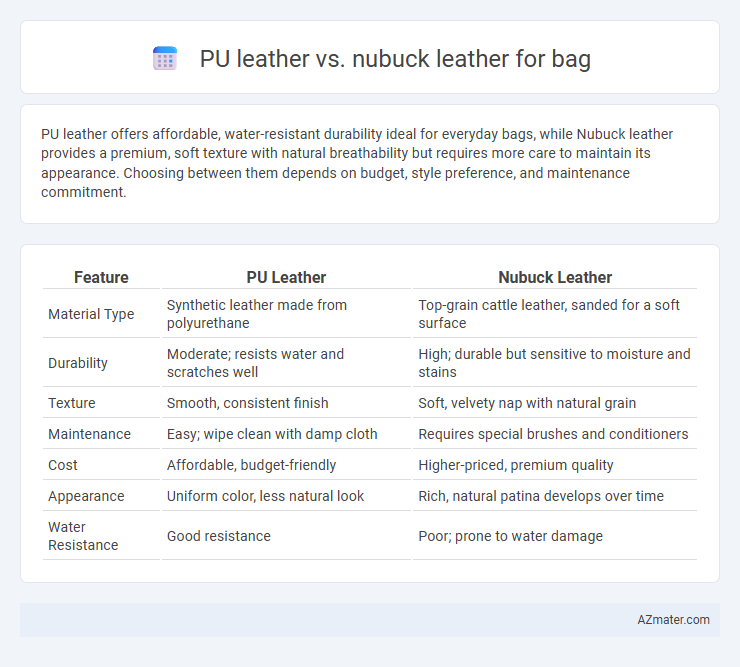PU leather offers affordable, water-resistant durability ideal for everyday bags, while Nubuck leather provides a premium, soft texture with natural breathability but requires more care to maintain its appearance. Choosing between them depends on budget, style preference, and maintenance commitment.
Table of Comparison
| Feature | PU Leather | Nubuck Leather |
|---|---|---|
| Material Type | Synthetic leather made from polyurethane | Top-grain cattle leather, sanded for a soft surface |
| Durability | Moderate; resists water and scratches well | High; durable but sensitive to moisture and stains |
| Texture | Smooth, consistent finish | Soft, velvety nap with natural grain |
| Maintenance | Easy; wipe clean with damp cloth | Requires special brushes and conditioners |
| Cost | Affordable, budget-friendly | Higher-priced, premium quality |
| Appearance | Uniform color, less natural look | Rich, natural patina develops over time |
| Water Resistance | Good resistance | Poor; prone to water damage |
Introduction to PU Leather and Nubuck Leather
PU leather is a synthetic material made from polyurethane coated on a fabric backing, designed to mimic the look and feel of genuine leather while offering enhanced durability and water resistance. Nubuck leather is a type of top-grain cowhide that has been sanded or buffed on the grain side to create a soft, velvety texture known for its natural appearance and breathability. While PU leather offers easy maintenance and affordability for bags, Nubuck leather provides a luxurious, supple finish that develops a unique patina over time.
Key Differences Between PU Leather and Nubuck Leather
PU leather, a synthetic material made from polyurethane, offers water resistance, easy maintenance, and affordability, making it ideal for budget-friendly bags. Nubuck leather, crafted from the outer side of a hide and sanded to create a soft, velvety texture, provides superior breathability, durability, and a natural, luxurious appearance but requires more care to prevent staining. Key differences include PU leather's uniform surface and synthetic origin versus Nubuck's natural, porous finish and higher price point, influencing selection based on style, longevity, and usage needs.
Material Composition and Manufacturing Process
PU leather is a synthetic material made by coating a fabric base, typically polyester, with a polyurethane layer, offering water resistance and uniform texture, ideal for budget-friendly bags. Nubuck leather originates from top-grain cattle hide, undergoing a sanding process on the outer side to create a soft, velvety surface that enhances breathability and durability. The manufacturing of PU leather involves chemical treatments and layering techniques, whereas Nubuck requires precise mechanical buffing and natural leather tanning for its premium feel.
Visual Appearance and Texture Comparison
PU leather offers a smooth, glossy finish with consistent color and a uniform surface, making bags appear sleek and polished. Nubuck leather features a soft, velvety texture created by sanding the outer layer of the hide, resulting in a matte finish with natural variations and a more luxurious, tactile appeal. The visual contrast is marked by PU leather's synthetic sheen versus Nubuck's muted, grainy surface, influencing the overall aesthetic and touch experience of the bag.
Durability and Longevity
PU leather offers excellent durability with high resistance to scratches, stains, and water, making it suitable for everyday bag use. Nubuck leather, made from top-grain cattle hide sanded for a velvety surface, provides a softer texture but requires more maintenance to prevent wear and water damage. While PU leather generally ensures longer lifespan for bags in harsh conditions, nubuck delivers premium aesthetics with moderate longevity when properly cared for.
Maintenance and Care Requirements
PU leather requires minimal maintenance, needing only occasional wiping with a damp cloth to remove dirt and prevent cracking, making it ideal for everyday use. Nubuck leather demands more careful care, including regular brushing with a soft brush to maintain its napped surface and the use of specialized leather conditioners to prevent drying and staining. Avoid prolonged exposure to water and sunlight for Nubuck to preserve its texture and color.
Water and Stain Resistance
PU leather offers superior water and stain resistance due to its synthetic coating, making it easier to clean and maintain for everyday use. Nubuck leather, treated from the outer side of the hide, absorbs water and stains more readily, requiring special protective sprays to enhance durability. Choosing PU leather ensures a more practical option for bags exposed to wet or dirty environments, while Nubuck offers a luxurious appearance with higher maintenance needs.
Environmental Impact and Sustainability
PU leather, a synthetic material derived from polyurethane, has a lower environmental impact than traditional leather due to its avoidance of animal farming but involves fossil fuel-based production processes contributing to carbon emissions. Nubuck leather, made from the outer layer of cattle hides, is biodegradable yet tied to significant environmental concerns such as deforestation, water use, and methane emissions from livestock. Choosing between PU leather and Nubuck involves weighing the synthetic pollution and finite resource use of PU against the ecological footprint and ethical considerations of animal-derived Nubuck.
Price and Value for Money
PU leather offers a budget-friendly option for bags, making it ideal for cost-conscious buyers while delivering decent durability and water resistance. Nubuck leather, although pricier, provides superior texture, breathability, and longevity, enhancing the bag's overall value for money with its premium feel and aging potential. Investing in Nubuck ensures a timeless, high-quality accessory, whereas PU leather suits those seeking affordable style with moderate lifespan.
Which Leather Is Best for Your Bag?
PU leather offers a durable, water-resistant surface ideal for everyday bags that require low maintenance and a wide range of designs. Nubuck leather provides a soft, luxurious texture with natural breathability and ages beautifully, making it suitable for premium, high-end bags but needing careful care to avoid stains. Choosing between PU and Nubuck leather depends on whether durability and ease of cleaning or premium aesthetics and texture are the priority for your bag.

Infographic: PU leather vs Nubuck leather for Bag
 azmater.com
azmater.com